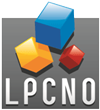Nanotech
Group’s equipments
Micro/nanofabrication tools
- Microcontact-printing set-up (conventional or electrical)
- Nanoimprinting set-up (conventional or electrical)
- UV-KUB2 Masking system
- Direct UV Laser lithography system Dilase 650
- Digital masking systems SmartPrintUV (Microlight3D)
- Ion etching
- Sputtering (SBT IBS/e)
- UV/ozone (Pico PCCE from diener / IntCo, 42-220 UVO cleaner from Jelight)
- Silane vapor deposition system
- Scriber
- Spin coater (spin 150 de sps-europe, Polos from Spincoating)
- Thermostatic bath (Julabo 200F)
- Corona plasma torch (ETP DB-20)
- Laminator (Fortex Laminator 505)
- Photoplotter (FilmStar-Plus from Bungard)
- Ovens (xfm020 from France étuves, Falc, Memmert UL-30, Binder
Deposition of colloidal nanoparticles
- 2 “in-house” set-ups for convective self-assembly of nano-objects under optical microscope, one of which is in a climatic chamber regulated in temperature and humidity and optimized for large surfaces
- “In-house” automated microfluidic set-up on inverted microscope, including MFCS -EZ pressure controls (2x 7 Bars, 345 mBar et -800 mBar), flow EZ 69 mBar, valves (2-Switch et M-Switch) from Fluigent et flow controllers (Nemesys S 3 channels from Cetoni)
Topographic characterization
- 2 BRUKER atomic force microscopes (AFM) equipped with a Nanoscope V controller: ICON and Multimodes 8
Several derived modes are available on these microscopes: electric modes EFM (Electric Force Microscopy) and KFM (Kelvin Force Microscopy), nanolithography, magnetic mode MFM (Magnetic Force Microscopy), Peak Force mode QNM and Extended mode TUNA. It is also possible to work in liquid media, to control the temperature of the sample (Heater/Cooler), and to work in an environmental chamber. Traction test could be performed using a tensile plate DEBEN placed under the ICON tip. - Optical profilometer (Profilm3D, Filmetrics)
Electrical characterization
- Cryogenic probe station JANIS ST-500
- KEITHLEY S4200C: C(V) et I(V) transport measurements, ultra-fast pulsed mode (Ultra Fast PMU KEITHLEY)
- The probe station is coupled to an “in-house” set-up including 5 lasers (405 nm, 532 nm, 640 nm, 785nm, 980nm) connected to an optical fiber
Optical characterization
- IX73 inverted microscope (OLYMPUS) equipped with PE300w fluorescence sources (reflection and transmission), a spectrometer (Ocean Insight OceanHDX) and a GrassHopper camera (GS3-U3-23S6C-C de Teledyne Flir)
- BX53M direct optical microscope (OLYMPUS) bright/dark fields, equipped with PE300w fluorescence sources (reflection and transmission) with polarization system (polarizers and analyzer) and a GrassHopper camera (GS3-U3-123S6C-C de Teledyne Flir)
- “In-house” ThorLabs photoluminescence set-up with Maya 2000 pro spectrometer, Märzhauser XY stage, Z from NewPort, laser PSU-III-LED from C.N.I. Optoelec. Inc.
- BX54M direct optical microscope (OLYMPUS) bright/dark fields in reflection mode with DP28 camera (+ stand-alone)
- BX41M direct optical microscope (OLYMPUS) bright/dark fields (+ fluorescence cube) in reflection mode with DP28 camera (+ stand-alone)
Mechanical characterization
- Deben 200N traction plate
- MTS (2/M) traction machine with 1kN and 5kN sensor
Electro-mechanical characterization
- “In-house” bench for electrical and optical characterization, coupled with mechanical constraints and temperature control (ranging from liquid nitrogen to room temperatures). Samples on flexible substrates (PET, polyimide…). The bench is connected to our electrometers (for very low currents) and to an impedance analyzer (Keysight) for impedance spectroscopy analysis.
Impedance spectroscopy characterization
- Keysight Impedance Analyzer EA4990A operating in the 20Hz – 10 MHz range
- VNA network analyzer operating in the 300kHz – 8.5GHz range with probe station in a black box.
Other characterizations
- DLS and Zeta potential: Beckman Coulter DELSA(TM)
- Contact angle measurements (GBX Digidrop)
- Climatic chamber (WKL 100 de Weiss)
